What Animals Live In The Rocky Mountains

Bighorn sheep (such as this lamb) have declined dramatically since European-American settlement of the Rocky Mountains.
The ecology of the Rocky Mountains is diverse due to the effects of a variety of environmental factors. The Rocky Mountains are the major mountain range in western N America, running from the far due north of British Columbia in Canada to New Mexico in the southwestern Usa, climbing from the Great Plains at or below i,800 anxiety (550 m) to peaks of over 14,000 feet (4,300 m). Temperature and rainfall varies greatly also and thus the Rockies are home to a mixture of habitats including the alpine, subalpine and boreal habitats of the Northern Rocky Mountains in British Columbia and Alberta, the coniferous forests of Montana and Idaho, the wetlands and prairie where the Rockies meet the plains, a different mix of conifers on the Yellowstone Plateau in Wyoming and in the high Rockies of Colorado and New United mexican states, and finally the alpine tundra of the highest elevations.
These habitats are home to a smashing bargain of wild animals from herbivores, such as elk, moose, mule deer, mountain goat and bighorn sheep, to predators like cougar, Canada lynx, bobcat, black bear, grizzly behave, gray wolf, coyote, fox, and wolverine, along with a great variety of pocket-size mammals, fish, reptiles and amphibians, numerous bird species, and tens of thousands of species of terrestrial and aquatic invertebrates and soil organisms.[1]
Permanent human settlement of the Rocky Mountains has acquired numerous species to refuse in population, including species of trout, birds, and sheep. Gray wolves and grizzly bears were almost eliminated from the United States portion of the range, simply are returning due to conservation measures.

The population of black bears in the Rocky Mountains is neither dramatically increasing nor decreasing.
Setting [edit]

Mount Elbert rises through multiple biotic zones, with alpine tundra at its height.
The Rocky Mountains range in latitude between the Liard River in British Columbia (at 59° N) and the Rio Grande in New Mexico (at 35° North), and in pinnacle upwardly to the highest acme, Mount Elbert at xiv,440 feet (4,400 m), taking in bang-up valleys such every bit the Rocky Mountain Trench and San Luis Valley. Precipitation ranges from 10 inches (250 mm) per yr in the southern valleys[2] to lx inches (i,500 mm) per twelvemonth locally in the northern peaks.[3] Average January temperatures can range from xx °F (−7 °C) in Prince George, British Columbia to 43 °F (6 °C) in Trinidad, Colorado.[4]
Biotic zones [edit]
Ecologists divide the Rocky Mountain into a number of biotic zones, defined past whether they tin can support trees, and the presence of one or more than indicator species. Areas of the Rockies that do not support or have few trees include the prairie of the eastern foothills and the Tall tundra. The foothill prairie grassland lies to the east of the Rockies where the mountains fall to see the Slap-up Plains at the Rocky Mountain Front (below roughly 1,800 feet (550 m)). Alpine tundra meanwhile occurs in regions in a higher place the treeline, which varies from 12,000 anxiety (iii,700 m) in New Mexico to two,500 feet (760 m) at the northern terminate (nigh the Yukon).[4]
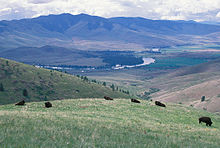
Bison grazing in grassland, Montana
The USGS defines ten forested zones in the Rocky Mountains.[1] The more southern, warmer, drier zones are defined by the presence of pinyon pines/junipers, ponderosa pines, or oaks mixed with pines. The more than northern, colder, wetter zones are defined by Douglas-firs, Cascadian species (such every bit western hemlock), lodgepole pines/quaking aspens, or firs mixed with spruce. Near the treeline, zones can consist of white pines (such as whitebark pine or bristlecone pine); or a mixture of white pino, fir, and spruce that appear as shrub-similar krummholz. Finally, rivers and canyons are domicile to unique forest habitats even in the more barren parts of the mountain range.[ane]
Biotic zones and vegetation types in the Rocky Mountains can be explained by elevation, aspect, and precipitation. Clinton Merriam recognized that two-dimensional diagrams of elevation and aspect described found community distribution in the Southern Rocky Mountains.[v] Other ecologists generally embraced this two-dimensional view until the complexities of environmental gradients such as temperature, atmospheric precipitation, solar radiations, wind, soils, and hydrology could exist described and modeled. Peet provided the nigh consummate description of 10 major forest customs types, which are summarized here.[6] Two nonforested vegetation types, plains and tall tundra, described past Sims[7] and Billings,[8] are added. Because of the variations in latitude and precipitation along this huge mountain range, the elevations presented here are gross generalizations.[ane]
Extensive investigations accept been fabricated of the forests of the Rocky Mountains.[six] Weber cautioned that the vegetation zones "overlap and telescope into each other considerably" in a landscape that is "always full of surprises."[ix] The resulting patchwork mosaic of vegetation types and disturbance regimes leads to a complex of side-by-side communities, wildlife habitats, and species distributions.[1]
Plains [edit]
The eastern side of the Rocky Mountains is bordered by mixed-grass prairie to the n and by short-grass prairie to the south. The prairie, some of which has been described as the Montana Valley and Foothill grasslands mostly extends to elevations of 5,900 feet (1,800 grand). Dominant plants of the mixed grass prairie include little bluestem, needlegrasses, wheatgrasses, sand-reeds, and gramas, with dropseeds and cottonwoods in riparian zones. Short-grass prairie species include little bluestem, buffalo grass, western wheatgrass, sand dropseed, ringgrass, needle-and-thread, Junegrass, and galleta.[7] Extensions of these vegetation types reach well into the Rocky Mountains along the valleys and on dry out slopes. Constitute species composition varies locally with changes in soil characteristics and topographic position—that is, from hilltops to valley bottoms.[1]
Riparian and coulee forests [edit]
Wide-leaved deciduous cottonwoods, alders, and willows, and aspens line streamsides and canyons. The herbaceous layer in riparian communities is often more various than upslope areas and adjacent forests.[6] Riparian and canyon vegetation types are generally too thin or too pocket-size to be displayed on regional vegetation maps, but the habitat is extremely important in the barren W.[i]
Pinyon-juniper woodland [edit]
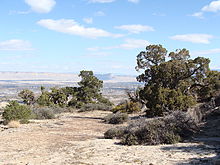
In the southern Rocky Mountains, a transition occurs between nearly 5,900 and eight,200 feet (1,800 and 2,500 m), where plains communities are accompanied by pinyon pines. Mexican pinyons and singleleaf pinyons are found in western Utah, alligator junipers and Rocky Mount junipers grow to the due south, and Utah junipers grow to the n. Many shrubs and grasses of the plains occupy the gaps between tree outcrops. Heavy livestock grazing is associated with the spread of junipers (by reducing competition from grasses), and fire suppression is partly responsible for their connected dominance.[1] [x]
Ponderosa pine woodland [edit]

Open ponderosa pino wood in Colorado
The appearance of ponderosa pino woodlands varies from scattered individuals in low-meridian or rocky areas to dense forests at higher elevations or on deeper soils.[half-dozen] Although ponderosa pines dominate the biomass of this customs, other tree species such equally Douglas-fir and Rocky Mountain juniper, shrubs (for example, raspberries, big sagebrush, gooseberries, currants, bitterbrush), and herb layers (such as mountain muhly, sedges, and sagebrushes) can develop. Typical intervals between natural fires are less than 40 years in most ponderosa pine forests.[1] Fires that recur every ten–twenty years suppresses the growth of Douglas-fir saplings and encourages the growth of ponderosa pine.[eleven]
In geological fourth dimension, ponderosa pine ecosystems are relatively new to the foothills of the central Rocky Mountains. An even newer addition to the ecosystem, European-American settlers, devastated the ponderosa pine forests through logging for houses, fencing, firewood, mine timbers, and railroad ties, and with fire. The ponderosa pino forests were close to the developing population centers at the forest-prairie border. The scale of the loss of ponderosa pine habitat is demonstrated all-time in several hundred paired photographs from the early on 20th century and 1980s. Nevertheless, near all the paired photographs too reveal that the virtually important characteristic of the ponderosa pine ecosystem is its resilience. Ponderosa pine seedlings plant quickly in disturbed sites. Enquiry in the Front Range of Colorado shows a tenfold increase in ponderosa pine biomass since 1890 in many stands. This regeneration has restored habitat for many wild animals species[ane] but has also led to unnatural woods densities in many areas.[12]
Pine-oak woodland [edit]
In the southern Rocky Mountains, lower slopes of ponderosa pine communities can be accompanied past Gambel oaks, other oak species (for example, Emory oaks, silverleaf oaks, netleaf oaks), and shrubs (such as sumacs, buckbrushes, and mountain-mahoganies). In the absence of fire, the oak stands may exist invaded past pines.[1] [6]
Douglas-fir forest [edit]
Douglas-firs grow in a broad range from Mexico to British Columbia, generally from almost lower treeline upward in superlative to spruce-fir forests. In Colorado, the species ranges from about five,410 to 8,860 anxiety (1,650 to two,700 yard) and is often found in mixed stands with ponderosa pine, blue bandbox, or lodgepole pine. Like ponderosa pino, Douglas-fir is tolerant of frequent, depression-intensity surface fires. High-intensity fire intervals in Douglas-fir forests in Wyoming average l–100 years.[1]
Cascadian forest [edit]
Several tree species ordinarily associated with the Cascade Mountains abound on the rain-swept western slopes of the northern Rocky Mountains. These include western hemlock, western redcedar, thousand fir, mountain hemlock, and larches.[13] These forests are discipline to infrequent, high-intensity fires.[ane]
Montane seral forest [edit]

Lodgepole pine forests interspersed with stands of quaking aspens are fire-resilient forests that dominate the central and n-central Rocky Mountains. Usually found betwixt eight,200 and 10,500 feet (2,500 and iii,200 chiliad) in Colorado, lodgepole pines and aspens abound speedily after burn down in mostly even-aged stands.[ane] In the Canadian Rockies, the lodgepole pino/quaking aspen forests occur in the foothills, mixed with white bandbox and balsam poplar.[thirteen] In the northern Canadian Rockies, black bandbox also occurs in this biotic zone.[xiii]
Intervals between fires typically range from 100 to 300 years. Every bit evidenced past the fires in the Yellowstone National Park in 1988, lodgepole pine forests are rejuvenated by crown fires that replace tree stands. Aspen stands are keystone communities for hundreds of birds and mammals and are especially important fodder for deer and elk.[ane]
Spruce-fir forest [edit]

The subalpine forests of the Rocky Mountains are characterized by spruces and firs and are floristically and structurally similar to the boreal conifer forests to the n. Ascendant tree species in the Colorado Rocky Mountains subalpine forests include Engelmann spruce and subalpine fir, as well as lodgepole pino and the occasional Douglas-fir. In the Black Hills of South Dakota, white spruce replaces Engelmann spruce. Further north are the lodgepole pine, Engelmann bandbox, and alpine fir mix of the Alberta Mount forests above 5,495 feet (1,675 thou) of elevation.[xiii] Stand-replacing fires typically occur at 200- to 400-year intervals. Widespread insect outbreaks in spruce-fir forests occur more than oftentimes.[1] Recently, bandbox bawl beetles have begun to impact more old-growth spruce copse in these forests.[14]
Subalpine white pino woods [edit]

A whitebark pine in Key Idaho.
On exposed, dry slopes at high elevations, subalpine white pine forests replace spruce-fir forests. Mutual species of the white pine forests include whitebark pine in the northern Rocky Mountains, limber pine in the central and northward-fundamental Rocky Mountains, and bristlecone pine in the southern Rocky Mountains. Typical intervals between fires range from fifty to 300 years. The white pines are tolerant of extreme environmental conditions and can be of import postfire successional species.[1] The whitebark pine is a keystone species in upper subalpine forests of the northern Rocky Mountains.[15] However, the whitebark pine has been in turn down due to white pine blister rust: whitebark pine mortality in some areas exceeds xc%. Entire forest vistas, like that at Avalanche Ridge almost Yellowstone National Park'due south east gate, are expanses of dead, greyness whitebarks.[16]
Treeline vegetation [edit]

Treeline is the elevation in a higher place which trees cannot grow. It is controlled by a circuitous of environmental conditions, primarily soil temperatures and the length of the growing season—which becomes shorter with higher elevations. The elevation of treeline rises steadily at the charge per unit of 330 feet (100 m) per degree of latitude from the northern to the southern Rocky Mountains. Dominant treeline species, including spruces, firs, and white pines, oft have a shrublike form in response to the farthermost conditions at the elevational limits of their physiological tolerance; such dwarfed trees are chosen krummholz. Krummholz islands may actually move virtually 3/4 inch per yr (2 cm) in response to the air current; they reproduce by vegetative layering on their lee sides, while dying back from air current damage on their windward sides. Under favorable climatic weather condition, krummholz tin can assume an upright treelike grade or can increase their cone crops and bulb establishment.[1]
Tall tundra [edit]
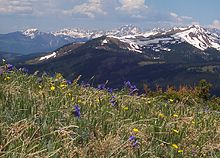
Tall tundra is a circuitous of high-elevation meadows, fell (barren) fields, and talus or scree (rock) slopes above treeline. Depending on latitude, treeline occurs between eleven,200 and thirteen,100 anxiety (3,400 and 4,000 m) in the U.s., and vii,220 and viii,040 feet (2,200 and 2,450 m) in Canada.[13] Grasses and sedges dominate the meadow communities, and fens (a blazon of wet meadow) and willows exist in wet soils. Vegetation in the alpine zone is similar to that in the Arctic: 47% of the plant species in the alpine zone of the Beartooth Mountains in Wyoming and Montana are also found in the Arctic.[eight] This loftier-diversity expanse includes alpine sage, tufted hairgrass, clovers, pussytoes, and succulents, and hundreds of grasses and wildflower species.[1] [8] [13]
Fauna [edit]
The Rocky Mountains are important habitat for a great deal of wildlife, such as elk, moose, mule deer, white-tailed deer, pronghorn, mountain caprine animal, bighorn sheep, black bear, grizzly bear, gray wolf, coyote, cougar, bobcat, Canada lynx, and wolverine.[one] North America's largest herds of moose is in the Alberta-British Columbia foothills forests.[one] The status of almost species in the Rocky Mountains is unknown due to incomplete data. Even bones regional information is non available on many nocturnal species (for example, bats, raccoons, and so forth); invertebrates; lichens, mosses, and fungi; and soil microorganisms.
European-American settlement of the mountains has adversely impacted native species. Examples of some species that are known to have declined include western toads, greenback cutthroat trout, white sturgeons, white-tailed ptarmigans, trumpeter swans, and bighorn sheep. In the Us portion of the mountain range, apex predators such equally grizzly bears and gray wolves had been extirpated from their original ranges, but accept partially recovered due to conservation measures and reintroduction. Other recovering species include the bald eagle and the peregrine falcon. Species such as the black bear and mount lion, many minor mammals, and common bird and plant species are described as stable considering, in about instances, the populations are persistent and not rapidly increasing or declining.[i]
Invertebrates [edit]
Although most of the animals in the Rocky Mountains are invertebrates, piddling is known about this component of the region's beast. As one entomologist[ who? ] stated, "Nosotros practice not know how many species of moths and butterflies alive in any land, county, or locality in North America".[17] In a few areas in the western United States, information is available on the species richness of moths and butterflies. Near of the Rocky Mount states and the Forepart Range of Colorado in particular support high species richness of butterflies and moths. In Colorado, the various habitats—from prairie to tundra—support nigh ii,000 species of butterflies, moths, and skippers; more than 1,000 species are in the Front Range. Some species of grasshoppers are unique to individual mountaintops in Colorado, New Mexico, Arizona, Nevada, and Utah. The Rocky Mount locust, a common pest to farmers in the 19th century, is at present extinct. Heavy grazing along river valleys in Montana and Idaho is thought to have irreparably destroyed locust breeding areas.[ane]
Amphibians [edit]

Globally, populations of amphibians are declining in size equally a result of habitat loss, predation by nonindigenous sport fishes, timber harvest, increased ultraviolet radiation, and affliction. The widespread declines of amphibian populations throughout the Rocky Mountains mirror these global trends. Western toads, once common between altitudes of 7,500 and xiii,800 feet (2,300 and 4,200 m) throughout the cardinal and northern Rocky Mountains, now occupy less than 20% of their previous range, from southern Wyoming to northern New Mexico. Eleven populations of western toads disappeared from the West Elk Mountains of Colorado between 1974 and 1982 considering of a bacterial infection and, perhaps, multiple sublethal environmental causes. The number of breeding sites in Rocky Mountain National Park has declined to merely 3. In the past 2 decades, western toads disappeared from 83% of their historical range in Colorado and from 94% of Wyoming sites. Populations of northern leopard frogs are significantly declining throughout the Rocky Mountains.[1]
Fish [edit]
The Rocky Mountains are home to a number of coldwater fish in the trout and salmon families, including rainbow trout, bull trout, lake trout, cutthroat trout, brown trout, beck trout, aureate trout, mount whitefish, Chill grayling, and Dolly Varden.[xviii] Many of these, however, are introduced, such as rainbow, chocolate-brown, and beck trout.
Colorado River cutthroat trout [edit]
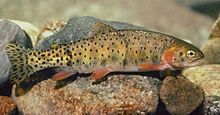
The Colorado River Cutthroat trout, a native of western Colorado, eastern Utah, northwestern New United mexican states, and southwestern Wyoming
Colorado River cutthroat trout were in one case abundant in mountainous tributaries of the Green and Colorado rivers, but non-native brown, beck, and rainbow trout had displaced them by the 1930s. They nonetheless survived in some isolated pockets, notwithstanding, and these populations have been used to restore the cutthroats to many areas in their celebrated range. One of the largest strongholds was, and is, Trappers Lake in Colorado's Flat Peak Mountains. However, in 1984, brook trout invaded because a flood done them downstream from nearby Crescent Lake. Past 2003, beck trout comprised forty percent of the lake's fish population. Beck trout have an advantage over cutthroat trout considering they spawn in fall. By the time Colorado River cutthroats hatch in Baronial, brook trout fingerlings may be able to eat them. Colorado Parks and Wildlife is controlling their population with large nets and selective removal.[xix]
Rio Grande cutthroat trout [edit]
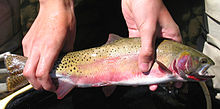
The Rio Grande cutthroat trout from northern New Mexico and southern Colorado
Rio Grande cutthroat trout currently alive on 700 miles of stream in the Santa Fe National Forest, which is approximately 91% of their historical range. The Rio Grande cutthroat trout was a candidate for listing under the Endangered Species Act from 2008 to 2014. In 2014 information technology was removed from candidacy as it was determined that listing was not warranted for this species.[20] [21] Rio Grande cutthroat accept the stardom of being the southernmost subspecies of cutthroat trout. All the same, due to the loss of populations across their native range and reports of Rio Grande cutthroat in Mexico and Texas, information technology is unclear how far south this trout once occurred. In 1955, it was designated the state fish of New Mexico.
Greenback cutthroat trout [edit]

A greenback cutthroat trout
The Greenback cutthroat trout was originally thought extinct in 1937. Nevertheless, in the 1950s, scientists institute putative cash on the eastern slopes of the Front and Sawatch ranges in Colorado. A campaign by Colorado Division of Wild fauna and several federal agencies introduced these fish to many areas in the trout'south former range. In 1996, it was designated equally Colorado's land fish. Then in 2012, researchers at the University of Colorado establish that the only pure population of these fish was in a modest stream in the Arkansas River basin, outside their native range. Since and so they accept been reintroduced to Zimmerman Lake on the edge of northern Colorado'due south Neota Wilderness and Sand Creek in Red Mountain Open up Space due north of Fort Collins.[22]
Yellowstone cutthroat trout [edit]

The Yellowstone cutthroat trout
Yellowstone Lake in Yellowstone National Park, Wyoming, is the site of the near contempo catastrophic species invasion. The Washington Post reported that the nonindigenous lake trout, a native of the Not bad Lakes, had been insidiously introduced into one of the nation's premier fisheries.[23] The native Yellowstone cutthroat trout may not compete well with lake trout considering lake trout swallow cutthroat trout. The potential ecological repercussions are staggering. If populations of cutthroat trout continue to decline, grizzly bears could lose an important posthibernation food because the native cutthroat trout spawn in the streams and are easy prey for the bears, whereas the nonindigenous lake trout spawn in deep water.[ane] The National park Service has begun an aggressive try to eradicate the invasive fish by hiring commercial fishing crews, and have removed over 1.7 meg with gill nets.[24] It is estimated that for every lake trout removed from Yellowstone Lake, 41 cutthroat trout are saved.[24] And then far the cutthroat trout have shown modest signs of recovery. However, other threats to the trout remain, such as whirling disease, brought from Europe by nonnative brownish trout.[25]
Mountain whitefish [edit]

Mountain whitefish fry in Yellowstone National Park
Mount whitefish, dissimilar cutthroat trout, take not declined significantly in their native range.[26] They are indigenous to much of Wyoming, Montana, and Idaho, likewise as Colorado'south Yampa River drainage. They take too been introduced to some areas outside of their native range, like the Poudre and Fryingpan rivers in western Colorado.
White sturgeon [edit]
The largest freshwater fish in the Rocky Mountains (and North America) is also in trouble. The white sturgeon historically ranged from the mouth of the Columbia River to the Kootenai River upstream to Kootenai Falls, Montana. The Kootenai River population of the white sturgeon is unstable and declining in size; fewer than ane,000 remain, 80% are older than 20 years, and virtually no recruitment has occurred since 1974, soon after Libby Dam in Montana began regulating flows.[1]
Birds [edit]
The Rocky Mountains are home to over 300 species of birds. These include raptor species that migrate through the mountains, such as gilded eagles, bald eagles, and ospreys. Owls, such as the great horned owl, the boreal owl, and the great grey owl make their homes in the forests. Ptarmigans are mutual above treeline. Many songbirds, including wrens, warblers, and finches[27]
Bald eagles [edit]

The coniferous and deciduous forests of North America have long been the dwelling of bald eagles. Bald eagle populations are now recovering later years of hunting, habitat destruction, and pesticide-induced deaths. In the early 1970s, Colorado had just one breeding pair of bald eagles just by 1993 biologists counted xix breeding pairs. In Wyoming nesting attempts increased from xx in 1978 to 42 in 1988. The baldheaded eagle has not even so fully recovered, all the same; pesticide residues continue to inhibit bald hawkeye reproduction, and habitat loss and atomic number 82 poisoning remain serious threats.[one]
Peregrine falcons [edit]
Peregrine falcons are cliff-dwelling raptors that once ranged through virtually of Northward America. Like the bald hawkeye, this species was driven to about extinction by pesticides. By 1965 fewer than 20 convenance pairs were known west of the Corking Plains. Even in the Greater Yellowstone ecosystem, federal spruce budworm control relied on Dichloro-diphenyl-trichloroethane, which accumulates in the nutrient concatenation, causing eggshell thinning and reduced reproductive success in raptors. Six breeding pairs of American peregrine falcons were found in Colorado in the early 1970s. By 1994, 53 pairs were breeding in Colorado. In Wyoming, Montana, and Idaho combined, 8 of 59 historical sites were used by falcons in 1987. Low breeding densities, reproductive isolation, habitat loss, and pesticide poisoning on wintering grounds remain threats to peregrine falcon recovery.[ane]
White-tailed ptarmigans [edit]

White-tailed ptarmigan in Alberta
White-tailed ptarmigans have been monitored in Rocky Mount National Park, Colorado, since 1966. Short-term population cycles are well documented in populations that are non hunted but not in populations exterior the park, which are hunted. Although detailed population size data are available from more than 28 years of monitoring, scant information is available on habitat change, predator populations, or other potential causes of modify in ptarmigan populations. In the park, the population seems to be increasing. A ii-twelvemonth study revealed lower ptarmigan densities where elk utilise was greater, although characteristics of willow, which is ptarmigan habitat, did non significantly differ in the high- and low-use elk sites. Furthermore, a two-year written report of ptarmigan habitat cannot explain 28-year trends in population size. Habitat loss and other factors partly responsible for ptarmigan deaths—such as predation and competition—were non studied during the 28-year period.[ane]
Ducks and geese [edit]

A bufflehead, 1 of many duck species found in the Rockies' lakes and streams
Many species of waterfowl inhabit the wetlands of the Rocky Mountains, including diving ducks such every bit goldeneyes and mergansers and dabbling ducks such as mallards and wigeons. Some species drift, while other species stay in the Rockies year-round. Canada geese are likewise commonly found here.[ citation needed ] Many ducks provide food for raptors such as baldheaded eagles and peregrine falcons every bit well equally an occasional coyote or bobcat.
Trumpeter swans [edit]

Trumpeter swan populations were seriously threatened in the 1930s; fewer than 70 birds were thought to be. At present protected from hunting, more than i,500 swans wintertime in the Greater Yellowstone ecosystem, but the size of the breeding population has declined in contempo years because of habitat loss.[1]
Neotropical migrant songbirds [edit]
Many forest-dwelling songbirds breed in the Rocky Mountains and winter in Central and South America. Wildlife biologists suspect that population size declines in the songbirds may be partly the result of increased predation and brood parasitism. Breed parasitism by brown-headed cowbirds, for example, increases as a upshot of nearby logging. In conifer forests in w-fundamental Idaho, common songbirds benefited from timber harvest, whereas the abundances declined of rare species that inhabit erstwhile-growth forests (hermit thrush, Swainson's thrush, and pileated woodpecker).[ane]
Mammals [edit]
Blackness bears [edit]
Black bears are the almost common bear species in the Rocky Mountains, ranging widely through the forested regions of the range. In Colorado, the largest populations of black bears alive in habitats with Gambel oak and aspen as well every bit chokecherry and serviceberry.[28] They can be seen feeding on berries, grasses, and small animals.[29] Colorado has a population of xix,000 of the bears, up from 12,000 in the early 2000s.[28]
Grizzly bears [edit]

Grizzly bears once roamed throughout the Rocky Mountains and the western Corking Plains. They were hunted relentlessly by European settlers in the 19th century and early on 20th century. The last known grizzly conduct in Colorado was killed in 1979. The decline of the bears to merely two% of their original range tells of the human-caused extirpation of large predators in the Rocky Mountain region. Just 700-900 grizzly bears may be alive today in the conterminous United states of america, with 300 grizzlies alive in the Canadian Rockies.[29] During the concluding 20 years, about 88% of all grizzly bears studied in the northern Rocky Mountains were killed by humans.[1] The U.Due south. Fish and Wildlife Service is because delisting the grizzly in Montana, Idaho, and Wyoming.[30]
Cougars [edit]
Cougars are one of the most important carnivores in the ecosystems of the Rockies. They prefer to prey on mule deer, but occasionally kill elk, white-tailed deer, and bighorn sheep, and in Alberta, moose kills accept been documented. Recently, cougars take recolonized many areas where they were eliminated in the 1800s and early 1900s, and have profoundly increased in number.[31] The highest densities of cougars are in foothill and montane areas, which are more than diverse and rich than subalpine or alpine environments.
Gray wolves [edit]

Gray wolves in Yellowstone National Park
Wolves one time were common throughout the Rocky Mountains. They were shot, poisoned, and trapped into local extinction by early settlers and federal agents. The last Gray wolf in Colorado was killed in 1940, and the wolf was outset listed as an endangered species in 1967. Wolves from southeastern British Columbia recolonized northwestern Montana in 1986; by 1994 the population had grown to 7 packs and about lxx-75 wolves. Wolves from Glacier National Park have dispersed naturally as far abroad as northeastern Idaho and just due south of Yellowstone National Park. A wolf was shot near Yellowstone National Park in 1992. From Jan to March 1995, 15 adult wolves from 7 different packs in Canada were introduced into primal Idaho wilderness areas. Several pairs have bred and produced the showtime litters of wolf pups built-in in Idaho in more than than fifty years. Xiv wolves (iii family groups) were released in the Yellowstone National Park in tardily March 1995.[1] A total of 66 wolves were released to the two areas in this fashion in Jan 1995 and January 1996.[32] Several wolves from the Northern Rockies have dispersed to the Southern Rockies but accept failed to plant a population in that location. Most have been killed.[33]
2013 estimates of wolf populations in the 2 recovery zones reflect the success the species has had in both areas:
- Greater Yellowstone Area: 460
- Primal Idaho: 684
These numbers, added with the estimated number of wolves in northwestern Montana (500), puts the total number of wolves in the Northern U.S. Rocky Mount recovery expanse at over 1500 individuals. This includes approximately 134 packs (ii or more than wolves traveling together) and 71 breeding pairs (male and female that successfully rear a litter of at least ii until Dec. 31). The recovery goal for the surface area was 30 breeding pairs total, and this number has been surpassed for some time.[34] In improver, there are at least 120 gray wolves in the Canadian Rockies.[35]
The restoration of the grey wolf to the Yellowstone National Park not only restores an of import ecosystem component (the wolf) and process (predation by wolves) to bring the park into better ecological balance, merely it also is economically sound. After weighing the costs (including total reimbursement to ranchers for the loss of livestock) and benefits (increased revenues from hunting and tourism), economists estimated (before the actual restoration took place) a net $18 one thousand thousand render during the commencement twelvemonth subsequently the wolves were returned, and about $110 million in 20 years. More tourists are expected to visit the area of the Yellowstone National Park and to stay longer in hope of hearing or seeing wolves in the wild.[36] Compensatory payments to ranchers for the loss of cattle and sheep to wolves averaged virtually $1,800 per yr in northwestern Montana.[1]
Mustelids [edit]

An American marten in Chiliad Teton National Park
Many types of mustelids inhabit the meadows, forests, and peaks of the Rocky Mountains. Types of weasels here include:
- Wolverine (Gulo gulo)
- American badger (Taxidea taxus)
- Northern river otter (Lontra canadensis)
- Pacific marten (Martes caurina)
- Fisher (Pekania pennanti)
- Long-tailed weasel (Neogale frenata)
- American mink (Neogale vison)
- Black-footed ferret (Mustela nigripes)
- American ermine (Mustela richardsonii)
Mustelids are some of the well-nigh of import predators of squirrels, mice, and voles, although wolverines can take down an animal every bit large as a caribou and the primary food of river otters is fish. Several species, including the river otter, black-footed ferret, and wolverine, accept declined over much of their range because of habitat loss, poisoning, and trapping, as well as refuse in prey species.
Cervidae [edit]
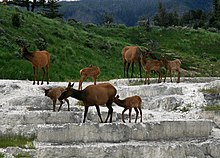
Members of the deer family (Cervidae) are relatively common in the Rocky Mountains, and include North American elk, mule deer, white-tailed deer, woodland caribou, and moose.
Population trends in North American elk and deer (mule deer and white-tailed deer combined) may exist heading in contrary directions. The number of elk has increased steadily in Colorado and Wyoming, whereas the abundances of deer are showing signs of decline. Elk on U.S. Wood Service lands in the Rocky Mountains increased from 268,000 in 1965 to 372,000 in 1984. Similarly, the number of elk on Bureau of State Management lands rose from 35,000 in 1966 to 114,000 in 1985. Meanwhile, the number of deer on U.S. Forest Service lands declined from one,742,000 in 1965 to 1,197,000 in 1984. Deer populations also declined on Bureau of Land Direction lands. Thus, in some areas in the final 20 years, the abundances of elk have increased past near twoscore%, whereas deer take decreased past about 30%. Possible reasons for the increase in elk populations include mild winters, range extension into lowlands and highlands, increased adaptability to homo-modified landscapes, and lack of predation in spite of increased hunting. The causes of the deer population declines remain unknown but may include excessive harvest in the 1970s and habitat overlap with elk, intensifying competition for similar resources.[1] Notation, withal, that deer population in the residual of the United States has increased fiftyfold betwixt 1900 and 2005, as hunting has been express and open space has been preserved.[37]
Woodland caribou were historically found in most of the northern Rocky Mountains, peradventure ranging every bit far s as Wyoming. They have declined dramatically over most of their range and take been eliminated in the Lower 48. Currently, populations are found in the Canadian Rockies, Alaska, and several other ranges. The primary crusade for their decline is the logging of old-growth forests. British Columbia is attempting to reverse their decline by culling the province'south abundant wolves.
Moose populations accept increased 50% since 1980 in Wyoming and accept been rapidly increasing since the reintroduction into Colorado commencement in 1978 and 1979.[1] Colorado currently has a thriving population of approximately 2,500 moose.[38] Nevertheless, in Yellowstone National Park, moose have declined from 1,000 animals in the 1970s to 200 in 1996.[39]
Pronghorn [edit]
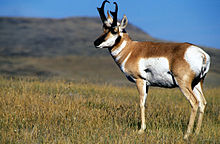
Many areas of the Rocky Mountains, notably Yellowstone and M Teton national parks, have significant populations of pronghorn. Many of these are migratory. Grand Teton's population migrates all the way from the Dark-green River Bowl each year, through many developed areas. Efforts have been made to preserve its migration road.
Bighorn sheep [edit]

Populations of bighorn sheep are at only about 2% to viii% of their sizes at the time of European settlement. Causes for the rapid decline from 1870 through 1950 included unregulated harvesting, excessive grazing of livestock on rangelands, and diseases transmitted by domestic sheep. In recent years, more than 115 translocations were made to restore bighorn sheep into the Rocky Mountains and into many national parks. Only 39% of the 115 bighorn sheep translocations are persisting in half-dozen Rocky Mount states. Populations of 100 or more sheep now occur in 10 national park units, populations of 100-200 sheep in v units, and populations of more than than 500 sheep in 5 units. Populations of fewer than 100 animals exist in five other park units.[i]
Bison [edit]
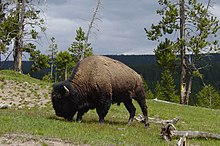
A bison most Yellowstone National Park's Mud Volcano area
In the 1800s, American bison throughout their range were exterminated to make room for livestock and drive Native Americans off the landscape, who depended heavily on bison. One of the few surviving genetically pure populations was in Yellowstone's Pelican Valley. The U.Southward. Army protected the bison until the National Park Service was established. In that location are currently between 4,000 and five,000 bison in the park. There are also herds in K Teton National Park, along Colorado's Front Range, in the San Luis Valley, and on Montana's Bison Range. Herds are existence established near Glacier National Park and in Alberta's Banff National Park.[40] Bison are a keystone species because their grazing and wallowing patterns create more diverse grasslands and meadows.[41]
Beaver [edit]
Beavers once played of import roles in shaping vegetation patterns in riparian and meadow communities in the Rocky Mountains. Studies of beaver populations in one small area in Yellowstone National Park (Tower Junction area) in the early 1920s reported 232 beavers and extensive beaver dams. Repeated surveys in the same expanse in the early on 1950s and in 1986 revealed no beavers or dams. Beavers need aspens or alpine willows for nutrient and building materials—resources that are made deficient by lack of both fires and floods and past herbivory by elk, moose, and domestic livestock. Beaver ponds are known to maintain fish and invertebrate populations and to create and maintain riparian zones that are disquisitional to wild fauna, all the same the beaver is well-nigh absent in many areas.[ane] By 2015, Yellowstone had an estimated 100 colonies. Causes for their increment include predation of elk by wolves, which allowed aspens and willows to grow taller.[42]

A least chipmunk in Glacier National Park
Squirrels [edit]
Many types of squirrel inhabit the forests of the Rocky Mountains, including several species of chipmunks such as the Uinta chipmunk and the to the lowest degree chipmunk. Overwinter chipmunk survival rates are less than a third.[43] Tree squirrels include the American ruddy squirrel (also known as pine squirrel), and the Abert's squirrel, institute merely in ponderosa pine forests. In that location are also several types of basis squirrels, such every bit the Wyoming basis squirrel, the rock squirrel, and the aureate-mantled ground squirrel.[44] [45] Squirrels are important to the forest considering they assistance spread the seeds of many plants. They are also a major food source for predators like martens, weasels, and hawks.[1]
References [edit]
- ^ a b c d eastward f g h i j k l m northward o p q r s t u v w x y z aa ab ac ad ae af ag ah ai aj ak al am
 This commodity incorporates public domain textile from the United States Geological Survey document: T.J. Stohlgren. "Rocky Mountains". (verbatim source)
This commodity incorporates public domain textile from the United States Geological Survey document: T.J. Stohlgren. "Rocky Mountains". (verbatim source) - ^ "Southern Rocky Mountains". Forest Encyclopedia Network . Retrieved August 22, 2010.
- ^ "Northern Rocky Mountains". Forest Encyclopedia Network. Archived from the original on July 21, 2011. Retrieved August 22, 2010.
- ^ a b Sheridan, Scott. "US & Canada: Rocky Mountains (Chapter xiv)" (PDF). Geography of the United States and Canada course notes. Kent State Academy. Archived from the original (PDF) on September 1, 2006.
- ^ Merriam, C. H. (1890). "Results of a biological survey of the San Francisco Mountain region and desert of the Picayune Colorado, Arizona". North American Creature. iii: 1–4. doi:ten.3996/nafa.three.0001. hdl:2027/hvd.32044102808680.
- ^ a b c d e Peet, R. Chiliad. (1988). "Forests of the Rocky Mountains". In Barbour, Chiliad. Chiliad.; Billings, W. D. (eds.). North American terrestrial vegetation. New York: Cambridge Academy Press. pp. 63–101. ISBN978-0-521-55986-7.
- ^ a b Sims, P. L. (1988). "Grasslands". In Barbour, Grand. K.; Billings, Due west. D. (eds.). North American terrestrial vegetation. New York: Cambridge University Press. pp. 265–286. ISBN978-0-521-55986-7.
- ^ a b c Billings, W. D. (1988). "Alpine vegetation". In Barbour, G. Thou.; Billings, W. D. (eds.). North American terrestrial vegetation. New York: Cambridge University Press. pp. 391–420. ISBN978-0-521-55986-7.
- ^ Weber, W. A. (1976). Rocky Mountain flora . Boulder: Colorado Associated Academy Press. ISBN978-0-87081-041-1.
- ^ Mullen, LD; et al. (1992). Biological Diversity. U.S. Section of Agriculture, Forest Service, Rocky Mount Region. p. 9.
- ^ Keane, RE; Arno, SF; Brown, JK (1990). "Simulating Cumulative Fire Effects in Ponderosa Pine/Douglas‐Fir Forests". Ecology. 71 (1): 189–203. doi:10.2307/1940259. JSTOR 1940259.
- ^ Covington, W. Wallace; Fule, Peter Z.; Moore, Margaret One thousand.; Hart, Stephen C.; Kolb, Thomas East.; Mast, Joy N.; Sackett, Stephen S.; Wagner, Michael R. "Restoring Ecosystem Health in Ponderosa Pine Forests of the Southwest" (PDF). U.Due south. Forest Service. U.S. Forest Service.
- ^ a b c d due east f Cameron, Ward (2005). "Life Zones of The Rocky Mountains". MountainNature.com.
- ^ "USFS Colorado spruce protrude map" (PDF). National Park Service. United states of america Forest Service.
- ^ Keane, Robert East. (1999). McCool, Stephen F.; Cole, David N.; Borrie, William T.; O'Loughlin, Jennifer (eds.). The importance of wilderness to whitebark pine research and management. Wilderness science in a time of change conference. Wilderness as a identify for scientific inquiry. Vol. 3. Missoula, Montana: U.S. Department of Agriculture, Forest Service, Rocky Mountain Research Station. pp. 84–92. Proceedings RMRS-P-fifteen-VOL-3.
- ^ Petit, Charles (January 30, 2007). "Science Department". New York Times.
- ^ Powell, J. A (1995). "Lepidoptera inventories in North America". In LaRoe, E. T.; Farris, Thou. S.; Puckett, C. E.; Doran, P. D.; Mac, Thou. J. (eds.). Our living resources: a study to the nation on the distribution, abundance, and health of U.South. plants, animals, and ecosystems. Washington, D.C.: U.Due south. Department of the Interior, National Biological Service. pp. 168–170.
- ^ Hempstead, Andrew. "Fish". Canadian Rockies. Moon Travel Guides. Archived from the original on August 17, 2012. Retrieved August thirteen, 2012.
- ^ Mitton, Jeff. "The tranquillity struggle between brook and cutthroat trout". Colorado College of Arts and Sciences. University of Colorado.
- ^ "Species Profile Rio Grande Cutthroat Trout". U.Southward. Fish and Wildlife Service. Retrieved July x, 2014.
- ^ New Mexico Game and Fish http://www.wild fauna.state.nm.us/rio-grande-cutthroat-trout-no-longer-an-endangered-species-candidate/
- ^ "Greenback Cutthroat Trout". Colorado Parks and Wildlife. Colorado Parks and Wild fauna.
- ^ Kenworthy, Tom (October 2, 1994). "Discovery of Alien Trout leaves Officials at Yellowstone reeling". Washington Post.
- ^ a b "Lake Trout". National Park Service. National Park Service.
- ^ "Whirling Disease". National Park Service. National Park Service.
- ^ "Mountain Whitefish". National Park Service. National Park Service.
- ^ Hempstead, Andrew. "Birds". Canadian Rockies. Moon Travel Guides. Archived from the original on August 17, 2012. Retrieved August 13, 2012.
- ^ a b "Colorado Parks and Wildlife". Colorado Parks and Wild animals. Colorado Parks and Wildlife.
- ^ a b Hempstead, Andrew. "Bears". Canadian Rockies. Moon Travel Guides. Archived from the original on Baronial 17, 2012. Retrieved August xiii, 2012.
- ^ "Grizzly Bears & the Endangered Species Act". National Park Service. National Park Service.
- ^ Chadwick, Douglas. "Ghost Cats". National Geographic.
- ^ "Wolf Restoration". National Park Service. National Park Service.
- ^ Fixler, Kevin (July 24, 2016). "Colorado wolf advocates, wildlife managers again feud over reintroduction". Superlative Daily.
- ^ "Rocky Mount Wolf Recovery 2005 Interagency Annual Report" (PDF). USFWS. Archived from the original (PDF) on May 24, 2006. Retrieved May three, 2006.
- ^ Hempstead, Andrew. "Wild Dogs and Cats". Canadian Rockies. Moon Travel Guides. Archived from the original on August 17, 2012. Retrieved Baronial thirteen, 2012.
- ^ French, Brett (September 27, 2021). "Montana wolf hunt criticized by Yellowstone Park superintendent". Billings Gazette . Retrieved September 28, 2021.
{{cite news}}: CS1 maint: url-status (link) - ^ "Deer eating away at forests nationwide". NBC News. January 18, 2005.
- ^ Wickstrom, Terry (August 13, 2016). "Moose populations are thriving in Colorado". Denver Post.
- ^ "Moose". National Park Service. National Park Service.
- ^ Goldfarb, Ben (March 24, 2015). "Bison to exist Reintroduced in Banff". Loftier Land News.
- ^ "Bison Ecology". National Park Service. National Park Service.
- ^ "Beavers". National Park Service. National Park Service.
- ^ Bergstrom, Bradley; Hoffman, Robert (1991). "Distribution and Diagnosis of Three Species of Chipmunks (Tamias) in the Front Range of Colorado". The Southwestern Naturalist. 36 (1): 14–28. doi:ten.2307/3672112. JSTOR 3672112.
- ^ "Squirrels and Chipmunks". National Park Service. National Park Service.
- ^ "Rock Squirrel - Spermophilus variegatus". Nature Works.
Farther reading [edit]
- Constantz, George. Ice, Fire, and Nutcrackers: A Rocky Mountain Ecology. Common salt Lake City: University of Utah Press, 2014. ISBN 978-1-60781-362-0
Source: https://en.wikipedia.org/wiki/Ecology_of_the_Rocky_Mountains
Posted by: seasedeaders50.blogspot.com

0 Response to "What Animals Live In The Rocky Mountains"
Post a Comment